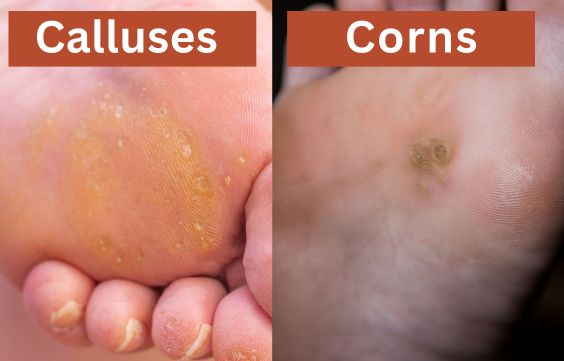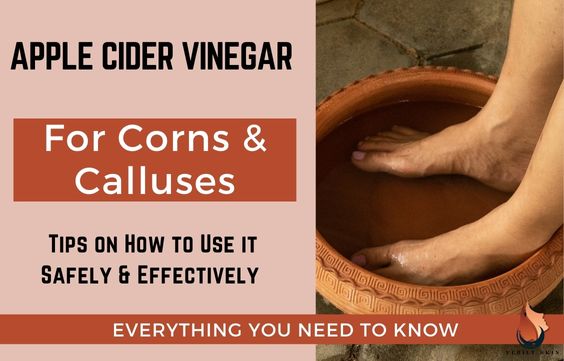Corns vs Calluses – What are the Differences & Types

In skincare, the most common body part of focus is the face. But what about our hands and feet? It is easier than you think to develop skin issues on your hands and feet.
Some of the most common issues people face are corns and calluses. In this article, we will talk about corns vs calluses: what they are, how they differ, and what causes each of them.
Difference Between Corns & Calluses
| Corns | Calluses |
| Corns tend to be smaller and more concentrated in one area. | Calluses tend to cover a larger area with a more irregular shape. |
| Corns tend to be more painful | Calluses tend not to be so painful |
| Corns are deeper | Calluses are more on the surface of the skin |

Related Articles:
Why Do Corns & Calluses Hurt & Easy Tips to Ease the Pain
What are Corns
A corn is an area of thickened skin with a painful central “core” that is caused by pressure or friction. Corns can develop on the fingers, palms, toes, or soles of the feet.
They generally start small and usually have a painful center or “core” which is surrounded by hard, inflamed skin. Without treatment or management, they get bigger and thicker. They also extend deeper into the skin and can become more uncomfortable and painful.
You need to read my article on Quick Remedies & Medical Treatments for Corns & Calluses
Types of Corns
Corns can be of three types:
- Hard corns – These usually develop on pressure points and the weight-bearing areas of your body. These include the soles of your feet or your palms (if you regularly lift heavy things), the top of the toes over the toe joints, and/or at the sides of the small toe.
With hard corns, the skin adapts and even the core becomes hard. It can hurt when you put pressure on the area and makes it difficult to walk, run or do daily activities normally.
- Soft corns – These usually develop on the non-weight bearing areas like between your fingers and between your toes. Soft corns are usually white-ish/grey in color and are thin and soft in texture.
- Seed corns – These develop most commonly deep in the skin on the soles of the feet (specifically the heels). They are usually discrete (sometimes not obvious when looking at the skin) but the person can feel them when they walk or apply pressure and weight to the area.
They can be uncomfortable or become increasingly painful as they remain untreated and develop deeper into the skin.
Related Article- Infected Corns & Calluses – How To Spot & Treat
What Are Calluses
Calluses are formed when the outermost layer of the skin becomes thickened and are usually painless. These usually occur in areas where there is constant friction and weight-bearing pressure.
Compared to corns, calluses are larger and generally have a more irregular and spread-out shape. They are usually yellowish in color but can also be grey or white-ish. Calluses are also evenly thickened all around and do not have central “cores”.
They are commonly found on the balls of your feet, heels, sides of your big toes, and/or along the sides of your feet.
Types Of Calluses
Calluses have been recognized medically to be of two types:
Diffuse Nucleated – this is a lesion that is spread out and evenly thickened but contains a small keratin plug (different from the core of a corn). Sometimes it is confused with a plantar wart because of the way it looks and feels.
Diffuse Shearing – this is a lesion that is spread out and evenly thickened as well but it does not contain the keratin plug.
Corns vs Calluses: How & Why (The Science Stuff)
Both corns and calluses are caused by anatomical factors that affect the area and/or mechanical factors that affect the area daily in an effort for the body to protect the skin.
What does this mean?
Some people have weirdly structured bones or areas in their feet that make daily physical activities or habits harder in the area and the skin. For example, an extra bony toe where the joints are more pronounced than usual, or hammertoe.
On the other hand, some people (either together with the anatomical problems or not) wear shoes that are not right for their feet, shoes that are too tight, or do regular activities that keep pressuring the area and causing friction.
As these things keep happening without proper management, the body starts to produce thickened skin to cover the irritated area and protect itself. These are the corns and calluses we see.
However, the kicker is that corns and calluses actually make the problem even worse because now the area has less space and will ultimately end up being more pressured and experiencing more friction. So a vicious cycle begins where the situation gets worse so the corns/calluses get worse and vice versa.
Corns vs Calluses: Are They Treated The Same Way
Treatment of corns and calluses will depend on how bad they are and the type. However, there are a few things in their management that are similar.
For both corns and calluses, you will need to:
- Reduce pressure and friction in the area
- Wear better shoes for your feet and/or condition
- Soak the affected area regularly to soften the skin
- Gently debride the area by using a file or pumice stone
- Moisturize the skin of the area regularly to keep the area as soft as you can
- See a professional to get them physically removed if self-treatment does not help
Click on these articles to learn more:
How Long Calluses & Corns Last & Do They Go Away Naturally
Tips on How to Prevent Calluses on Your Hands
7 Tips on How to Prevent Calluses & Corns on Your Feet
Here are a few great ways that dermatologists suggest managing corns and calluses at home:
Check out the articles below to learn about things you can use at home for Corns & Calluses:
Salicylic Acid for Calluses & Corns: What You Need to Know
Hydrogen Peroxide for Corns & Calluses: How to Safely Use
Apple Cider Vinegar For Corns & Calluses – What To Know
Best Essential Oils & Body Oils to Treat Corns & Calluses
Sources
Corns and Calluses: Overview of Common Keratotic Lesions
AAFP – Corns and Calluses Resulting from Mechanical Hyperkeratosis
How to treat corns and calluses
The Feet People – Corns & Calluses Corns and calluses Information | Mount Sinai – New York






